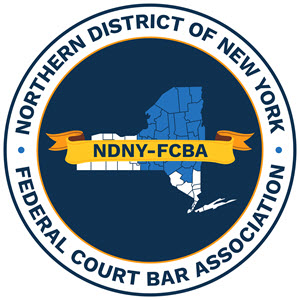NDNY-FCBA
Constitutional
Scholars
Program
TOPICS
1. "The Independence of Federal Court Judges." In a PDF poster or YouTube video, answer each of these five questions in detail:
(1) What are at least three different ways the Constitution makes federal court judges independent, and where are those ways found in the Constitution?
and where are those ways found in the Constitution?
(2) What/who does each way make such judges independent from?
(3) Why does each way do so?
(4) What does Canon 5 of the Code of Conduct for United States Judges do, and how does it help?
(5) What does the Courthouse Ethics and Transparency Act do, and how does it help?
Hint: See Federalist Papers Nos. 78, 79 and 81.
2. "The Enumerated Powers of Congress." In a PDF poster or YouTube video, answer each of these five questions in detail:
(1) What are the 17 enumerated powers of Congress, and where are they found in the Constitution?
(2) What is a real-life example of each power?
(3) Rank the powers from most important to least important in your opinion, and explain the reasons for your ranking.
(4) What is the 18th power in this section, and how does it relate to the others?
(5) What is the major debate regarding this 18th power, and why is the answer to that debate important?
3. "The Amendments to the Constitution." In a PDF poster or YouTube video, answer each of these five questions in detail:
(1) What are the different ways that the Constitution may be formally amended, and where are those ways found in the Constitution?
(2) What are the 27 amendments to the Constitution?
(3) What is a real-life example of each of the rights that are protected by those amendments?
(4) Rank the amendments from most important to least important in your opinion, and explain the reasons for your ranking.
(5) What new amendment(s) would you propose and why?
4. "If [People] Were Angels." In a YouTube video only (not a poster), recite FROM MEMORY
(without reading it) James Madison’s “If men were angels” passage from Federalist Paper No. 51 (Feb. 8, 1788), then discuss what you think it means and why.
[T]he great security against a gradual concentration of . . . powers in the same department[] consists in giving to those who administer each department the . . . constitutional means and personal motives to resist encroachments of the others. . . . Ambition must be made to counteract ambition. The interest of the [person] must be connected with the constitutional rights of the place. It may be a reflection on human nature that such devices should be necessary to control the abuses of government. But what is government itself, but the greatest of all reflections on human nature? If [people] were angels, no government would be necessary. If angels were to govern [people], neither external nor internal controls on government would be necessary. In framing a government which is to be administered by [people] over [people], the great difficulty lies in this: you must first enable the government to control the governed; and in the next place oblige it to control itself. . . .


